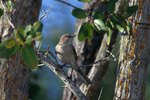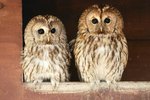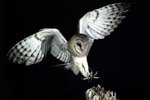
At 17 inches tall, the laughing kookaburra is the largest member of the kingfisher family. Australia natives, these birds live in eucalyptus forests and suburban parks and gardens, particularly on the country’s east coast. Best known for its laughing calls at dawn and dusk, the bird has been nicknamed “the bushman’s alarm clock.” Early European explorers were less than amused, however -- when traveling in unfamiliar areas, they noted the birds seemed to be mocking them.
Territorial Ownership
Kookaburra families gather year-round at sunrise and sunset to announce their territorial boundaries. Adult kookaburras mate for life and occupy the same territories for at least a year. Family groups include both parents, hatchlings or nestlings, and four or five grown young. The older siblings help their parents for a few years by incubating the eggs and feeding the young once they’ve hatched. At around 4 years of age, young kookaburras leave the family group to find mates and establish territories of their own.
Breeding and Family Relations
The kookaburra’s loud laugh softens to a quiet chuckle during their spring mating season. These more intimate croons are employed by male kookaburras to soothe and calm the breeding females. Soft squawks and chuckles can also be heard during courtship prior to mating. Young kookaburras use these same sounds to beg for food or as a sign of submission toward more aggressive siblings, which explains why calls increase in frequency when nestlings fledge.
Other Calls
Kookaburras make calls similar to those they use to broadcast territorial ownership when they are trying to locate family members, although these calls are shorter in duration. An intense “koooaa” sound serves as an alert to some sort of outside threat, while a sharp cackle asserts dominance and indicates an imminent attack on another bird.
Aboriginal Folklore
The kookaburra has long been a part of Australian culture. One aboriginal legend explains the bird’s raucous morning laughter as a signal to the sky people to start the day by lighting the great fire that warms and illuminates the Earth. In another tale, the god Bayame ordered the kookaburra to laugh loudly each morning and awaken all of mankind to view the sunrise. Australian aborigines have long respected kookaburras and believed a child would grow an extra, slanting tooth if he insulted the bird.
References
Photo Credits
-
Hemera Technologies/AbleStock.com/Getty Images
Writer Bio
Jennifer Mueller began writing and editing professionally in 1995, when she became sports editor of her university's newspaper while also writing a bi-monthly general interest column for an independent tourist publication. Mueller holds a Bachelor of Arts in political science from the University of North Carolina at Asheville and a Juris Doctor from Indiana University Maurer School of Law.




